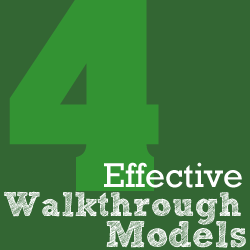Walking the Walk: 4 Effective Walkthrough Models
By Kimmie Etheredge Communicator December 2014, Volume 38, Issue 4
By Kimmie Etheredge
Communicator
December 2014, Volume 38, Issue 4
 For the past two years, we’ve been on a mission at Granger Elementary School to increase the effectiveness of our Tier I instruction. Our campus had grown quickly (tripling enrollment in just six years), and we began to observe “cracks” in our academic foundation. We surveyed our staff to determine proficiencies in fundamental reading and math instructional practices and discovered that our experiences were as varied as the processes of delivery we were observing.
For the past two years, we’ve been on a mission at Granger Elementary School to increase the effectiveness of our Tier I instruction. Our campus had grown quickly (tripling enrollment in just six years), and we began to observe “cracks” in our academic foundation. We surveyed our staff to determine proficiencies in fundamental reading and math instructional practices and discovered that our experiences were as varied as the processes of delivery we were observing.
My leadership team and I developed a master schedule that secured blocks of daily, common grade-level planning/conference time to enhance lesson design. Next, we began designing differentiated staff development in effective, research-based instructional practices, such as the workshop model for reading and math, and guided reading and balanced literacy components.
Once this was in place, we knew we had to establish a monitoring method to determine areas of success or concern. To meet our state and district evaluation requirements, our campus administrators conduct at a minimum one 10- to15-minute evaluative walkthrough. But beyond that, our school also uses daily impact walkthroughs, focused walkthroughs, instructional rounds, and peer observations.
Here is a snapshot of each of these walkthrough methods.
Daily Impact Walkthroughs
Daily impact walkthroughs, conducted by the principal, ensure the quality of instruction in the building is consistent. This may be for a brief observation to look at student work, observe a lesson, or talk with students.
Purpose: To monitor individual teacher instruction and progress, and align instruction throughout building.
Participants: Principal, assistant principal, campus instructional teacher, and grade-level leadership team members.
Feedback: Each teacher should receive some type of written feedback at least 3-5 times a semester. Feedback is not necessary for every visit.
Length: Approximately 15 minutes per visit.
Frequency: An administrator should visit each classroom every week.
Focused Walkthroughs
During weekly-focused walkthroughs, a principal is looking specifically for district protocols and schoolwide foci. We decide on these in August of each year, based on our data and campus needs. We determined, for instance, our instructional focus this year would be to implement learning targets to focus instruction for both the teacher and student. There’s a four-member team for each learning target. Each of these grade-level teams completes two focused walkthrough observations a semester.
Purpose: To deliver non-evaluative, descriptive feedback to teachers.
Participants: Administrator and 2-3 other staff members; grade-level teams.
Feedback: Lead person is responsible for meeting with host teacher to deliver feedback.
Length: Approximately 15 minutes per visit.
Frequency: Weekly.
Instructional Rounds
Instructional Rounds are observations that focus on the designated instructional focus for the current year. Teams consist of four members who observe 3-5 classrooms to look for instructional alignment or outliers that impact effectiveness and student learning. Team members script what they observe and what they hear and classify information into four quadrants: patterns that support the instructional focus, patterns that work against the instructional focus, reflective questions for administration, and next steps defined.
Purpose: To deliver non-evaluative, descriptive feedback.
Participants: Grade-level leadership team, led by administrators
Feedback: Share trends from the instructional rounds process with all staff—no individual feedback is given.
Length: Approximately 10-15 minutes per visit.
Frequency: Minimum of twice per semester, and should be frequent enough to observe patterns of instruction and progress.
Once the information is gathered, the team determines patterns that either support or work against our current instructional focus, create clarifying questions for the teacher, and help develop the next step in the growth process.
Peer Observations
Teachers complete two peer observations at a time per semester, and with a teacher of choice. This is one of our most popular observations. During library time or a guidance counselor lesson for their class, teachers visit a peer’s classroom. These observations give them a chance to support one another, and teachers enjoy them.
Purpose: To deliver non-evaluative, descriptive feedback.
Participants: Individual teachers.
Feedback: Feedback is given to administration who then shares it with the teacher.
Length: Varies.
Frequency: Each teacher conducts two observations per semester.
Results
These walkthroughs help our school craft professional development plans. At our twice monthly leadership team meetings, we gather and disaggregate data. We determine a “plan of action” based on data and feedback. We finalize professional development plans and we enter the cycle of continual growth again.
When we surveyed teachers in May 2014, teachers stated that now, with this new cycle, professional development is more purposeful and impacts their teaching. Our data supported their assertions that children were more successful in their learning. Now, with these walkthroughs as part of our plan, professional development is viewed as personal and differentiated and essential to teachers’ growth. Overall, it’s a win-win for everyone.
Kimmie Etheredge is principal of Kay Granger Elementary in Keller, Texas.
—
Copyright © 2014. National Association of Elementary School Principals. No part of the articles in NAESP magazines, newsletters, or website may be reproduced in any medium without the permission of the National Association of Elementary School Principals. For more information, view NAESP’s reprint policy

